Table of Contents
Bucktooth Tetra: A Quick Summary
The Bucktooth Tetra (Exodon Paradoxus) is a small, freshwater fish native to South America. It is known for its distinctive, oversized front teeth and shimmering silver-blue coloration. Bucktooth Tetras are popular among aquarium enthusiasts for their peaceful temperament and hardiness. They are easy to care for and adapt well to a variety of tank conditions.
Bucktooth Tetra Overview
Exodon paradoxus, or Bucktooth Tetra, is a difficult fish to raise, and many fish keepers claim it is even nastier than the well-known Piranha.
They have a distinct personality, although they are robust and thrive in huge single-species tanks. They require a separate tank for their survival. Their name is amusing because they are not buck-toothed whatsoever, but they can still eat the scale of other fishes.
Bucktooth Tetra is little, growing up to 2.9 inches long, yet they may bully bigger fish like cichlids until they become ill from distress. Here is a reliable Bucktooth Tetra care guide.
| Information Chart | Bucktooth Tetra |
| Scientific Name: | Exodon Paradoxus |
| Family: | Characidae |
| Care Level: | Hard |
| Temperament: | Aggressive |
| Color: | Metallic silver with hints of red, green, yellow |
| Lifespan: | Up to 10 years |
| Size: | 4 to 5 inches |
| Diet: | Chopped prawns, clams, bloodworms, plankton, lance fish, or earthworms and all dead substitutes. |
| Minimum Tank Size: | 55 gallons for a group of 12 |
| Temperature: | 73-82 degrees Fahrenheit |
| Water Conditions: | Slightly acidic (5.5-7.5 ph.) |
| Tank Mate Compatibility | Incompatible |
Bucktooth Tetra Appearance
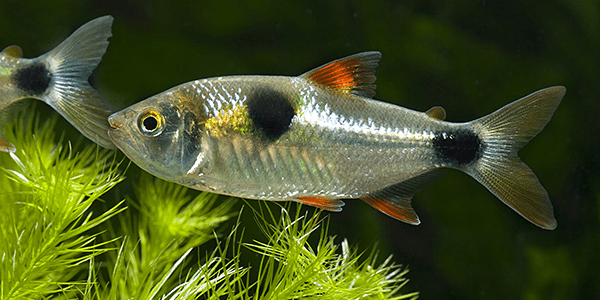
The look of the bucktooth tetra is identical to that of other tetra fish. They’re torpedo-shaped, tiny, and brightly colored!
Shiny silver is the primary color. The silver, on the other hand, is flecked with yellow, green, and red. Two huge patches also accent the midsection. One is located in the middle portion of the body, while the other is found at the base of the tail. The flippers are translucent with a yellow tinge. The dorsal fin, pectoral, and anal fins are covered in red and orange speckles.
However, on the tail, specks of a richer yellow offer a splash of color! These freshwater fish do not have jutting teeth, despite their imaginative name. Their teeth, on the other hand, are relatively distinct. The teeth are pointy and fairly keen to aid the fish’s scale-eating behavior. They can readily shred through even the most difficult fish scales!
The teeth and lips are oriented outwards, allowing them to cause more harm and attack other fish. As frightening as this may sound, it’s pretty challenging to see their fangs until you look very closely.
Lifespan Of Bucktooth Tetra
The typical lifespan of a Bucktooth Tetra is ten years. Bucktooth tetras, like any fish, require well-kept surroundings and a balanced diet to live to their full potential. They are aggressive fish by nature. These fish may succumb to sickness and die prematurely if not given proper maintenance.
Bucktooth Tetra Size
The typical Bucktooth Tetra grows up to 4-5 inches when held captive and 6 inches for wild specimens growing out of the tank.
Natural Habitat and Origin
The bucktooth tetra is a member of the tetra family, but it’s not the tranquil society fish you’re used to. Instead, this freshwater fish, known scientifically as Exodon paradoxus, is a voracious and ferocious hunter.
The bucktooth tetra is recommended for experienced fish keepers because it can be aggressive towards other species in the tank. They’re among several Amazon River Basin scale-eating animals. Fish will form a group and have their scales ripped off one by one.
Bucktooth tetras can be found in the wild in Brazil and Guyana. This breed is still readily available in the aquaculture industry, despite not being as famous as their pacific counterparts. Many aquarists consider them a must-have because of their beauty and fierce temperament.
Bucktooth Tetra Care & Tank Set-Up
Bucktooth Tetra Tank Size and Specifications
Optimum Tank Size for Bucktooth Tetra

First and foremost, if you wish to keep these fish, you’ll need a large tank. A tank that can accommodate no less than 55 gallons is recommended for a set of 12 bucktooth tetras.
If you think that’s a lot of fish for a small fish, consider the following:
Bucktooth tetras are very restless and require a lot of room to move and roam. In addition, they are shoaling fish. Therefore, to avoid dispute and cannibalism, you must keep a large tribe united.
The recommended community tank size for Bucktooth Tetra is 55 gallons.
Tank Shape for Bucktooth Tetra- Big
Filter Type- Always use a high-quality filter, as large groups of fish produce a considerable bio-load that the filter must handle. Lack of optimum water quality may also influence their behavior, causing Bucktooth Tetras to fight one another.
Substrate
How Many Bucktooth Tetra in A 55-Gallon Tank?
At least a group of 12 or more Bucktooth Tetra should be kept together.
Water Parameters for Bucktooth Tetra
Water Temperature
The ideal water temperature for Bucktooth Tetra is 72–82-degree Fahrenheit.
Water conditions should be consistent to avoid stressing the fish and affecting their immune response. The ideal temperature is from 73 to 82 degrees Fahrenheit.
pH Level
pH Level- Between 5.5 to 7.5, the pH will be somewhat acidic. They prefer slightly acidic water. The Bucktooth Tetra loves soft water with a temperature range of 0 to 20 degrees.
The perfect water pH level for Bucktooth Tetra is between 5.5 and 7.5.
Water Hardness
The Bucktooth Tetra prefers soft water.
Bucktooth Tetra Tank Landscape
These fish aren’t very fond of hiding in plants. For that, they’re just too energetic and energetic! They do, nevertheless, prefer to be able to zip through certain foliage.
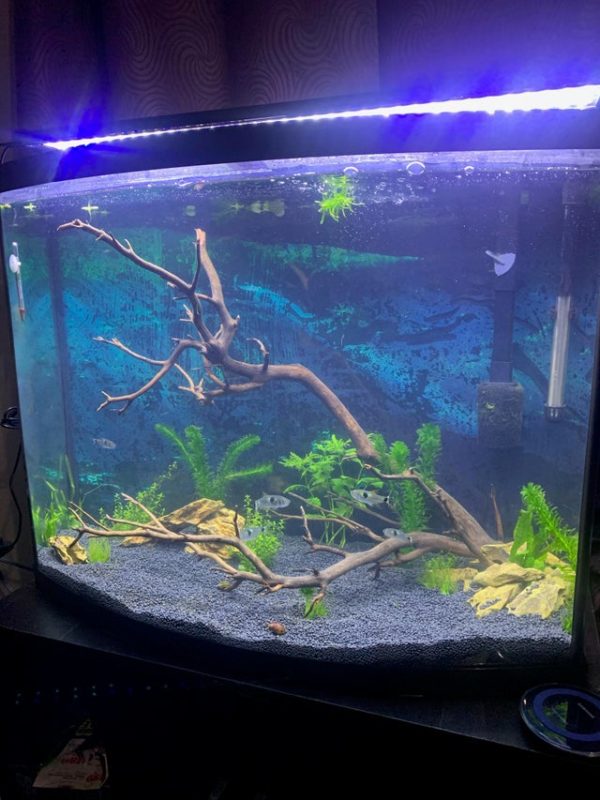
These fish would benefit greatly from a mixture of vegetation. Plants like Java fern and Amazon swords are good choices. In addition, plants that look like grasses in the front and a few floating plants in the tank are fantastic choices.
Best Plants for Bucktooth Tetra Tanks
Java and Amazon Swords
Worst Plants for Bucktooth Tetra Tanks
By its very character, the Bucktooth Tetra likes to be surrounded by as many plants as feasible. It not only keeps the water well-oxygenated, but it also gives your fish more than enough places to hide. Unfortunately, they don’t always want to be sociable, and they’re also frightened out on occasions.
That’s when they start trying to find a place to shelter, and there’s nothing easier than blending in with the surrounding vegetation. These plants reduce the amount of increased water filtering needed.
Decorations For Bucktooth Tetra Tanks
As this species isn’t fond of floating plants, it’s best to buy something else. Driftwood pieces can be added to the mix to make the whole thing more beautiful.
Of course, stones, pots, and artificial caves are possibilities as well. Based on how many you would like to keep; you must acquire a tank between 30 and 60 gallons in size. Bucktooth Tetras enjoy wide and long fish tanks since they are pretty energetic and need plenty of room to swim about.
Feeding Bucktooth Tetra
Best Diet for Bucktooth Tetra
Bucktooth Tetras exist in the wild on bugs since they are vicious predators and greedy feeders. Therefore, they eat scales of other fish species if they can chisel away at some. This does not, though, imply that you must maintain them on a tight diet at home. They need enough food for their survival.
Rather than feeding them live food, you can give them mussels, crustaceans, grubs, mollusks, other fish’s scales, and lance fish. Dried foods from the pet store, like pellets and granules, are also appropriate. However, the general norm is to give them meaty foods the majority of the time.
It’s vital to remember that Bucktooth Tetras are naturally aggressive carnivores. They seem more than willing to devour any insects that may be found in the house.
For them, these are ultimate treats. If you maintain this breed with other fish, it will take meaty food from them anytime feasible.
As a result, you should be closely attentive about whether your remaining fish are being fed adequately. Unfortunately, little amounts of food can be given to the Bucktooth Tetra numerous times per day.
How Often Should You Feed Bucktooth Tetra?
Bucktooth Tetra should typically be fed every few hours, several times a day.
Bucktooth Tetra Behavior and Temperament
Bucktooth tetras must remain in bunches to survive. Unlike most other freshwater species, though, this isn’t a question of fear or trepidation. Instead, whenever these fish aren’t in a huge group, they attack one another!
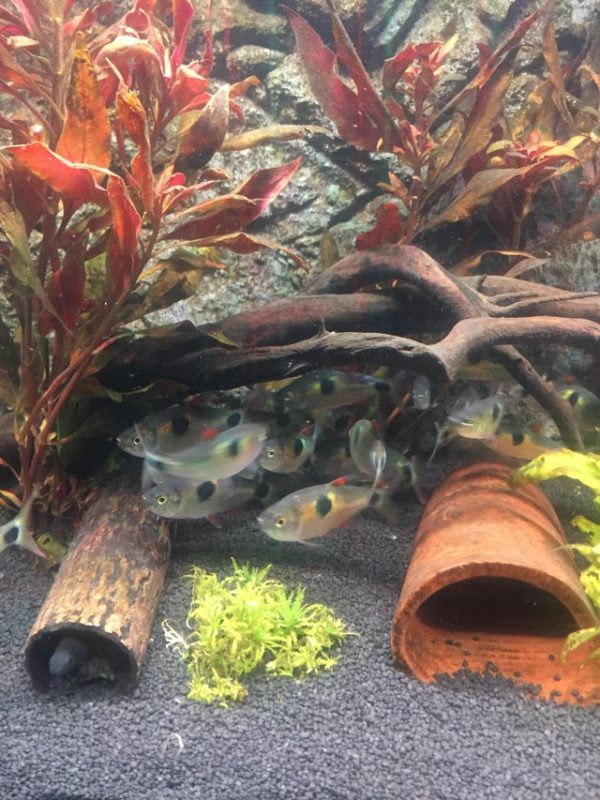
There is no precise science for calculating the number of fish required to avoid this. However, groups of at least 12 are usually adequate. Don’t be hesitant to get a swarm of 25 to 50 if you have a huge tank!
No solitary bucktooth will be hunted down and killed in big groups. Instead, they’ll band together and concentrate on any ill or sickly fish.
Whenever these fish swim collectively, they can make a tremendous flash of color. They’ll zoom about the tank to investigate and swim because they’re so energetic. They can move in harmony, but they will occasionally split up and do their own business!
Is Bucktooth Tetra Lone or Societal in Nature?
Bucktooth Tetras are predatory fish. If you add another creature to the aquarium, it will turn into a battleground. Therefore, a single species aquarium is best for these fish.
Nevertheless, if you maintain them by their species, they will feel patient. This is particularly applicable if they are kept in huge schools. They’ll move together in such a way that will be entertaining to see. You’ll quickly forget about their naturally hostile disposition.
Maintaining a smaller group of Bucktooth Tetras, on either hand, is a high-risk proposition. They will aggressively assault each other if the school is too tiny. The battle will continue until just one fish is left. We believe it is not worth the gamble; thus, you should get a more considerable amount.
The amount of Bucktooth Tetras in a school of 20 to 25 is ideal. This will assure that they will work together peacefully. At least a dozen of them must be in the same tank.
When any one of them becomes ill, they will eventually be eaten by others. They’ll pick out the weakest members of the squad and punish them mercilessly. If you notice that one of them isn’t feeling good, you can isolate him in a different tank till he recovers.
Bucktooth Tetra Tank Mates
Being such an aggressive predator, the best thing to do is keep these fish with their own kind. Large schools are the best because they keep together and interact peacefully with each other. On the other hand, a smaller school would force them to pick on one another until only one remains.
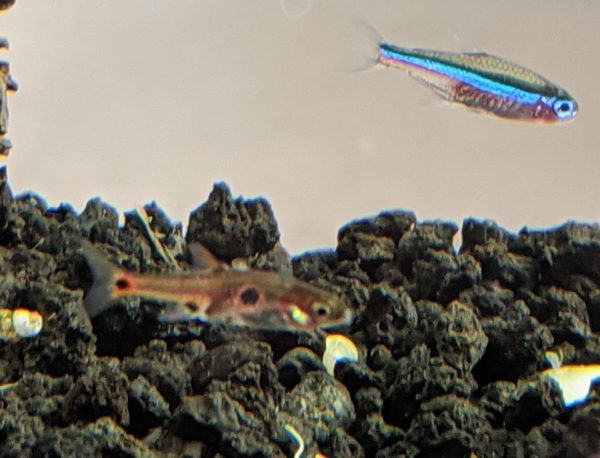
Larger schools of 20-25 fish would prevent any of them from being attacked, and usually, only the sick or weakened specimens would be attacked.
Ideal Bucktooth Tetra Tank Mates
- Loricariids
- Loaches
- Larger characins like Anostomus
Bad Tank Mates for Bucktooth Tetra
Bucktooth tetra can be kept with the species mentioned above, but it is still very hard to tell if these fish would still get along well. New additions may be regarded as food, so make sure you add the Bucktooth last in your tank.
Breeding Bucktooth Tetra
Bucktooth Tetra breeding is not something encouraged for absolute novices. Among more seasoned fish keepers, it is rare. It’s difficult enough to keep a female and a male in the very same tank. Rather than mating, there’s a reasonable probability they’ll clash with one another.
Furthermore, you will be unable to determine which is the male and which is the female. There are no exceptional circumstances between them. Therefore, the only way to keep a large school of Bucktooth Tetras, both males, and females, is to maintain a big school. It will happen someday if you wait long enough.
On the other hand, you must be ready to extract the eggs as early as possible. Ultimately, the parents will consume them, and your goal will be thwarted. This difficulty can be handled by properly arranging the aquarium so that long and narrow areas are present.
Females like to deposit their own eggs there since it will be difficult for the parents to access them and consume them. The Bucktooth Tetra is known for eating its eggs and fry. You’ll have to separate the fry from the adults because they can’t survive together.
You can raise them in a different water tank if you take adequate care of them.
Bucktooth Tetra Breeding Level
- Hard
Bucktooth Tetra Sexual Dimorphism?
To distinguish between a male and a female Bucktooth Tetra, there are no determinations visible. They, if in the same tank, would fight more than being calm.
Bucktooth Tetra Common Diseases and their Treatment
With the bucktooth tetra, there have been no unique health concerns. They are, nevertheless, susceptible to all of the diseases that affect other aquatic species.
These fish species are susceptible to ich bacterial illnesses (such as fin rot) and parasites.
The terrific news is that the majority of significant health issues may be avoided. Bucktooth tetras are tough, and they can be affected by drastic temperature or pH changes. Ammonia and nitrate accumulation in the water can also cause significant problems.
To keep things in good shape, ensure proper water conditions to make sure you’re employing a robust water filter.
Is Bucktooth Tetra Right for You?
Just those fish owners who enjoy violent fish should consider the Bucktooth Tetra. If kept in a specific species tank, this rare and beautiful fish will live a quiet existence. The best part about them is that they need a smaller aquarium size compared to Piranhas or Cichlids.
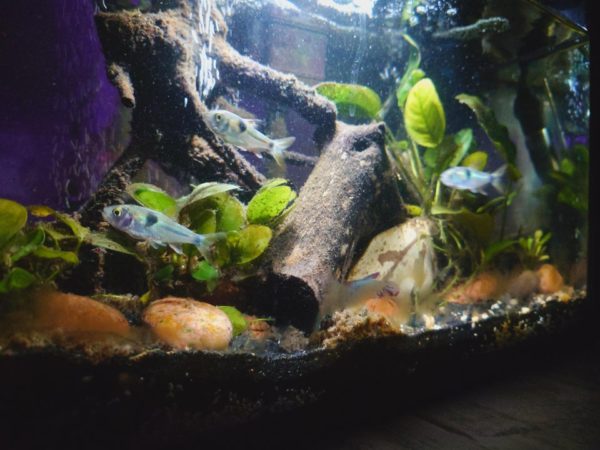
They nevertheless allow you to have a school of vicious animals on the prowl. It would be best if you didn’t have any troubles as long as you keep many of them. We hope that this essay has inspired you to keep these small carnivores in a tank and appreciate their individuality.
Bucktooth Tetra facts
- As the name suggests, the Bucktooth Tetra does not match its name at all. It is rather hard to see teeth that require close attention to be noticed by people.
- They are like piranhas; it takes hardly any time to turn a living organism into a carcass.
Frequently Asked Questions
Are The Bucktooth Tetra Aggressive?
Yes. The Bucktooth Tetra is a highly aggressive species of fish that prey on other creatures for survival.
Is Bucktooth Tetra an Easy Fish to Keep?
No. Bucktooth Tetra is mainly for experienced fish keepers. They are tricky to maintain by novice fish keepers and might go out of hand if not monitored closely.
How Many Bucktooth Tetra Can You Keep Together?
A group of 12 or more is ideally recommended to be kept together.
What Is the Tank Size of Bucktooth Tetra?
A tank size of 55 gallons is recommended for Bucktooth Tetra.
Conclusion
Bucktooth tetra is a resilient, one-of-a-kind, and ultra-aggressive species that face distinct hurdles before it can be succeeded in keeping in an aquarium. Finding tank companions for these species and adapting with their species can be difficult. They are violent towards all scaled fish and any fish with a silvery sheen, and they torment small fishes of their very own type.
They are indeed an eye-candy when handling a school of 10 or more, despite their ravenous instincts. If you like an energetic school with a nice appearance, we recommend trying to handle this fish.

3 thoughts on “Bucktooth Tetra: Complete Guide to Care, Breeding, Tank Size and Disease”
Exodon Paradoxus should be written as Exodon paradoxus (species not capitalized) and either underlined or italicized
Is it safe to put your hand in the aquarium to perform maintenance I’ve seen videos of these guys eating and they are very aggressive towards meaty things
Yes it is safe they have nipped me before but it doesn’t hurt